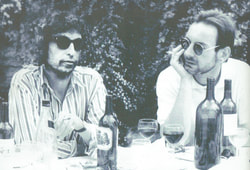Back in the 60s, we had an invasion of Australian intellect and intellectuals. Richard Neville, editor of Oz, Clive James and the incomparable Germaine Greer, were crucial to the movement at the time, and their energy, smartness and engagement, were important - at least to me - in facing up to one or two bourgeois tendencies that I had inherited from my public school.
These days, I love the Australian earthiness, their drinking, their love of sport and what Dame Edna famously referred to as their “total lack of cultural distractions”.
So, on our recent visit to London for Bob's return to the Royal Albert Hall, Jill and I found a couple of hours to see the Australia show at the Royal Academy.
Not, of course, for the colonial, imperialist, landscapes of the English painters, although some of the painting is more than competent and the subject matter fascinating.
The wondrousness of the show was all about the exquisite, obsessive, detailed and scale of the work of the native Australians.
Aboriginal art is both style and substance.
The style is decorative, reminding me of Arabian, Iranian, Turkish carpets, in which religious icons are combined with images of heritage, to create something which is greater and more universal than either.
Some contemporary Australians, of European heritage, have attempted to continue this tradition, and they have failed quite spectacularly.
Others, notably Sidney Nolan, have drawn on the landscape to create something as modern and as distinctively Australian as Wolf Blass Shiraz. Some are particularly successful in capturing the banality of Australia in the 50s, against which the three mentioned above rebelled and from which they escaped: Jeffery Smart, in particular, completely new to me, deserves a wider audience.
But, for the Europeans, the native technique is merely and only that, a technique. They seem to me to fail to understand that the medium is as much the message as ... well, the message. This is also the case in the work of the so-called Australian impressionists. It's ok, but it’s not quite there, is it? It may be Australian, but it's not impressionist. And when it is impressionist, it's not Australian.
There is no doubt, however, that it was an afternoon exceptionally well-spent, and well worth the annual cost of our Friends of the RA cards.
With the exception of a load of where-the=hell-do-we-put-this? stuff in the final couple of rooms, it was moving, engaging, challenging and stimulating. We loved it.
And we also loved the new Keeper's House bar and restaurant. Under the aegis of Oliver Peyton and, during the day, open exclusively to Academicians and Friends, it is our very own club in Piccadilly. The Wolseley is just across the road, but, for once, we didn't visit. No need. The Keeper's House will do me very well indeed when I revisit the RA to see the Daumier on Paris exhibition in the new year.
So that's what we did before the Bob concert. Read the preceding blog for a review of the concert itself. My judgement may not be what you expect.
Meanwhile, because this was all happening the day before Thanksgiving, and I needed to be back in Leamington for Michelle's celebrations, I mused on the train about all the things for which I can give thanks this year.
For me, that means a second grandson, a first step-grandson, and the marriage of my second daughter Cassidy to a man I admire and respect and who is good for her.
And then, there was the World Series.
That's a good year by any standards.
Today from the everysmith vault: Wooden Ships from October 1991. Paul Kantner returns to his folk roots in the back room of McCabe's guitar shop in Santa Monica.It was just after the death of Bill Graham, and Paul recounts a conversation he had had earlier with Jerry. Very moving







 RSS Feed
RSS Feed